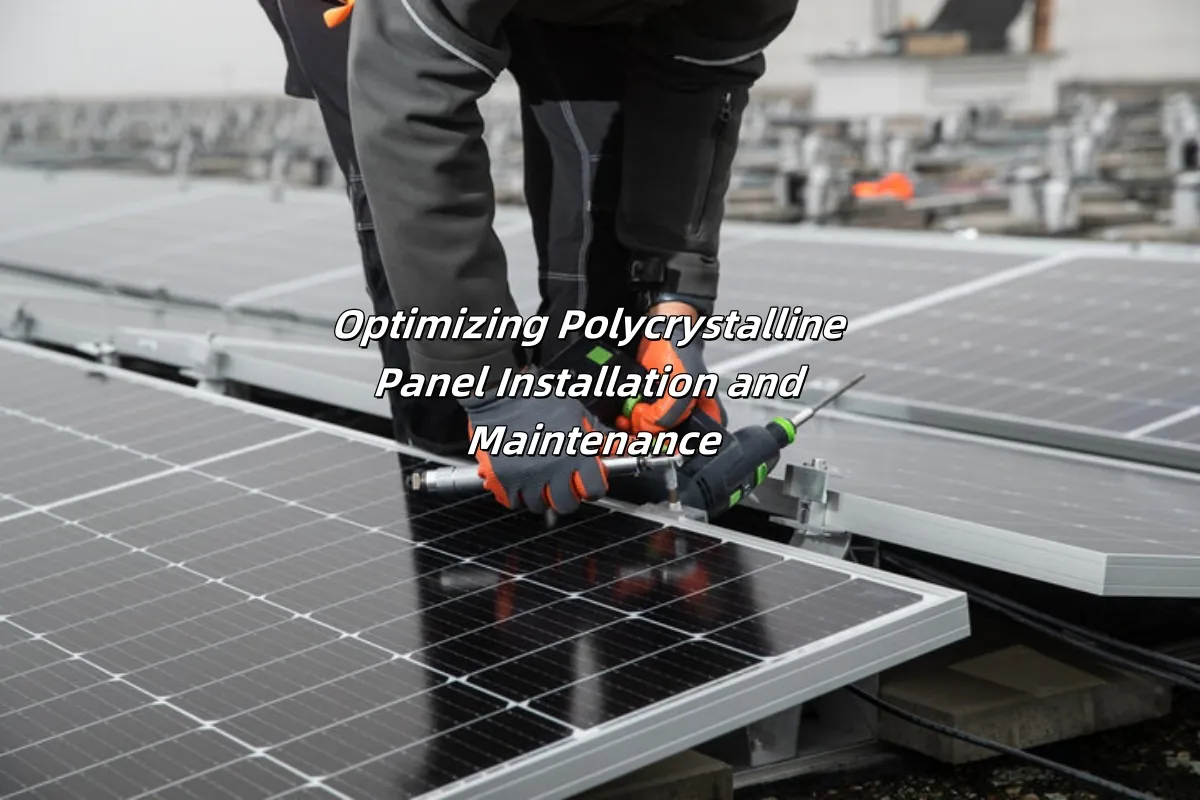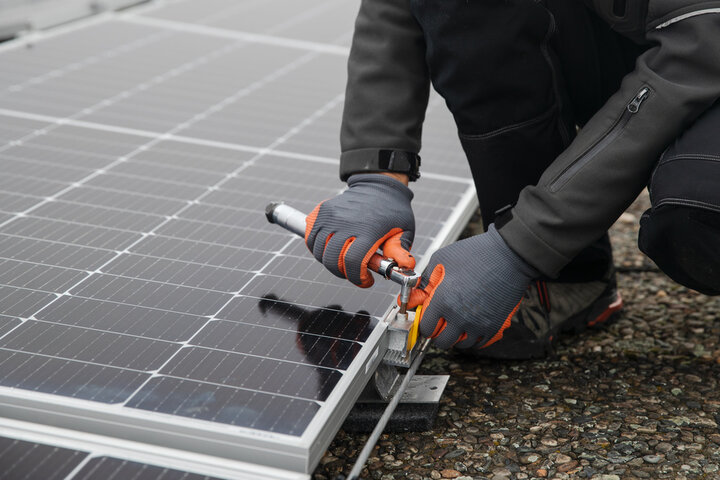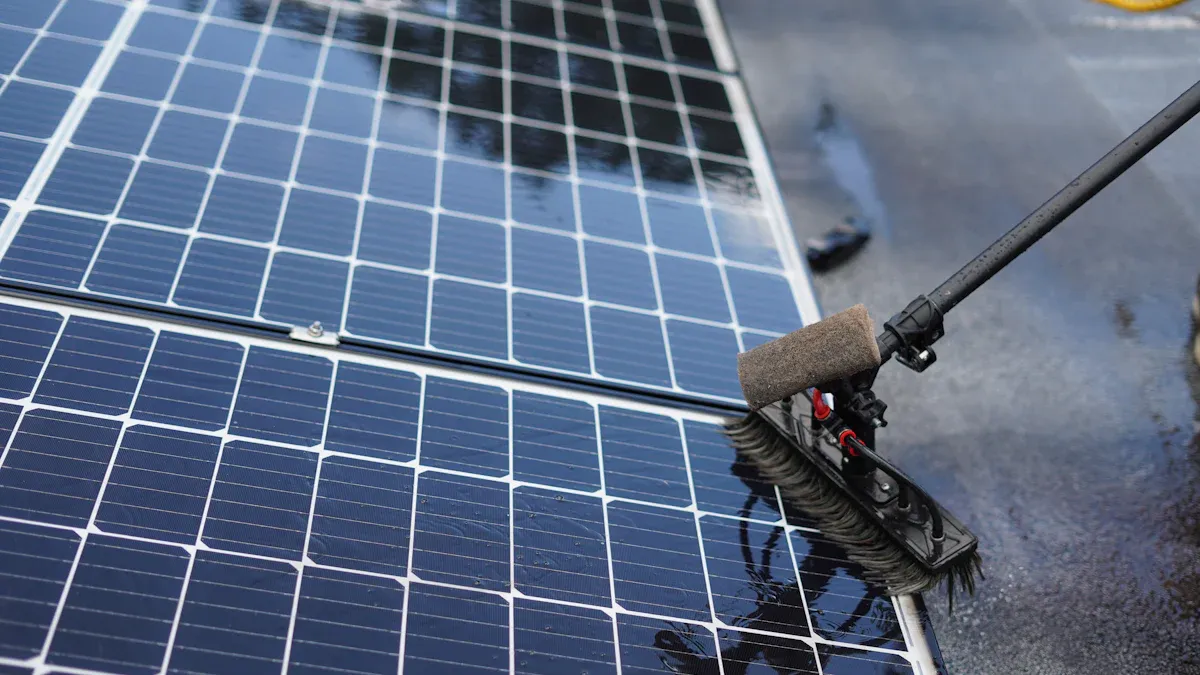+86 17727759177
inbox@terli.net
- All
- Product Name
- Product Keyword
- Product Model
- Product Summary
- Product Description
- Multi Field Search
Views: 0 Author: Site Editor Publish Time: 2025-09-25 Origin: Site
As a pv professional, you face special technical problems with polycrystalline panels, even though these panels are no longer used in global solar production. You often deal with wiring damage from pests, weather wear, circuit breaker problems, and inverter issues. If you use best practices, focus on better optimization, and keep learning new things, you can make every system work better, last longer, and be more reliable.

Check the site and shading very carefully before you start. This stops power loss and keeps hotspots from causing damage.
Change the tilt and direction of solar panels when seasons change. This helps make more energy all year.
Look at your solar panels often and take care of them. This lets you find problems early and makes the system last longer.
Follow safety rules when you install or fix solar panels. This keeps workers safe and protects the solar system.
Think about adding upgrades like half-cut cell modules and battery storage. These upgrades help the system work better and give more energy freedom.
Every solar project should begin with a site and shading check. If you ignore shadows, you can lose almost half your panel’s power. Efficiency drops a lot if you do not look for shadows first. Hotspots can happen on panels and get very hot, up to 92.3°C. These hotspots hurt the panels and make them last less time.
Tip: Walk around the site at different times. Use a solar pathfinder or a similar tool to find shadows.
Shading makes each panel give less power.
Hotspots can ruin solar panels forever.
You need to keep panels away from trees and buildings.
Set the direction and tilt of each panel to get the most energy. The best angle and way to face depends on where you live. Use the table below to help place panels in different cities:
| City | Winter Tilt Angle | Summer Tilt Angle |
|---|---|---|
| Lahore | 50.80° | 5.90° |
| Faisalabad | 50.70° | N/A |
| Karachi | N/A | 6.50° |
| Mirpurkhas | N/A | 6.50° |
| Peshawar | N/A | N/A |
| Islamabad | N/A | N/A |
| Bahawalpur | N/A | N/A |
| Sukkur | N/A | N/A |
| Gwadar | N/A | N/A |
| Quetta | N/A | N/A |
Change the tilt for each season to get more energy. Putting panels at the right angle helps them work better.

Check the mounting structure before you install any panels. The structure must hold all the panels and stand up to wind, snow, and shaking.
Dead loads are the weight of panels and hardware.
Live loads come from wind and snow.
Make sure the structure can hold extra weight in storms.
| Factor | Description |
|---|---|
| Load Factors | Wind, snow, and shaking can change how strong the structure is. |
| Material Selection | Pick strong materials so the panels stay safe and last long. |
| Installation Methods | Attach panels to the roof or use ballasted systems to keep them in place. |
Good mounting keeps panels safe and working for a long time. Check every bolt and attachment before you put up the panels. This step stops problems later and keeps your solar panels safe.
You need to put each panel in the best spot. This helps the panels get more sunlight and work better. First, check the roof to see if it gets enough sun. Look for things that might block the panels. Put the panels so they face south. Set the tilt to match where you live. This helps you get more energy from your solar panels.
Here are the steps for placing panels:
Check the roof for sunlight. Make sure nothing blocks the sun.
Decide where to put the panels. Face them south and set the right tilt.
Get the roof ready. Clean it and fix any damage before you start.
Put the panels on the mounting structure. Leave space between them for air to move.
Change the angle if needed. Adjust the tilt for each season to get more energy.
Tip: Try using a solar pathfinder. It shows where shadows fall and helps you pick the best spot for each panel.
Putting panels in the right place makes your system work better. Always check your work before moving on.
You have to make safe electrical connections so your solar system works well. Always follow the rules to keep yourself and the system safe. Wear gloves, safety glasses, and boots that do not conduct electricity. Follow OSHA rules when you install the system.
Here are some important steps for electrical work:
Wear the right safety gear every time you work.
Use Lockout/Tagout steps. Make sure the power is off before you start.
Check all wires and connectors. Look for broken or loose parts.
Connect the panels to the inverter and main system. Double-check every connection.
Check the system often after you finish. This helps you find problems early and keep the panels working well.
Note: Always check and take care of your system. This helps you find electrical problems and keeps your panels safe.
Good electrical work helps your system last longer and keeps you safe. Always follow the safety rules when working with solar panels.
You must always follow safety rules when you install solar panels. This keeps you and others safe. Wear gloves and helmets. Use fall protection when working on roofs. Keep your electrical safety gear close and use it when needed.
Here are some safety rules to follow:
Wear gloves and helmets for every job.
Use fall protection on roofs.
Make sure you have electrical safety gear and use it.
Have a plan for emergencies.
Go to training often to learn new safety skills.
Callout: Safety is the most important thing for every pv professional. You must follow these rules to stop injuries and keep your solar work safe.
Always look over the safety rules before you start. Good safety habits help you avoid mistakes and make your solar panels work better.

Image Source: unsplash
You need to check your panels often to keep them working well. Regular checks help you find problems early. This helps your solar system last longer. At first, check your panels more often in the first year. Later, you can check them once a year as they get older.
| Inspection Type | Frequency |
|---|---|
| Routine visual inspection | At least once a year |
| In-depth inspection (including electrical) | Every five years |
| Inspection after extreme weather | As needed |
| System inspection for performance drop | As needed based on monitoring data |
In the first year, look at your panels every 3 to 6 months.
After the first year, check them once a year to keep them working.
Always look at your panels after storms or if they stop working as well.
Tip: Checking your panels often helps you find small problems before they get worse. This keeps your panels working longer and helps them make more energy.
Dirt, dust, and bird droppings can make your panels work less well. You should clean your panels often so they make more energy. The best way to clean depends on where you live and how much dust is around.
Use a soft brush or cloth with sodium solution to clean by hand. This works for most panels.
Use compressed air to blow off loose dust without scratching the panels.
If you live in a dusty place, clean your panels every 10 days. If it is not very dusty, clean them every 15 days.
Robotic cleaning systems can help if you have many panels or if cleaning by hand is hard. These robots use soft cloths and air to clean and protect the panels.
Super-hydrophobic coatings can keep dirt from sticking to the panels. This makes cleaning easier and helps your panels work better.
Electrostatic cleaning systems can take off up to 90% of dust. This helps your panels last longer.
Note: Do not use high-pressure water or strong chemicals. These can hurt your panels and make them not last as long.
You may find some common problems when you take care of your panels. Knowing how to fix these problems helps your panels last longer and work better.
Sometimes, you will see loose wires, pinched wires, or leaks. Check all the wires and fix them right away.
If your solar inverter stops working, your panels will not make energy. Keep your inverter updated and use the warranty if you need repairs.
If you have trouble with communication, check all the wires and internet devices. Call a professional if you cannot fix it.
Ground and arc faults are dangerous. Only trained people should fix these problems to keep everyone safe.
Squirrels and rodents can chew on wires. Put up guards to keep animals from hurting your panels.
Callout: Always follow the rules for maintenance and safety when you fix problems. Acting fast keeps your panels working and helps your solar system last longer.
Checking your panels, cleaning them, and fixing problems quickly helps you get the most from your polycrystalline panels. These steps protect your money, help your panels work better, and make them last for many years.
You need good monitoring systems to check your solar panels. These systems help you find problems early. They also help keep your panels working well.
Standalone solar monitoring systems show you how much energy you make.
Environmental sensors check temperature, sunlight, and wind speed. These things change how well your panels work.
Software shows live data and gives alerts when you need to fix something.
Tip: Use monitoring tools to see if your panels make less energy. If you act fast, you can stop problems and keep your panels working.
You can make your solar system work better by upgrading parts. Half-cut cell modules work better in shade and stop hot spots. These upgrades help each panel make more energy and last longer. Smart module technology helps each panel work its best.
| Feature | Half-Cut Solar Panels | Traditional PV Modules |
|---|---|---|
| Power Losses | Up to 50% fewer | Higher losses |
| Hot Spot Temperature Reduction | Up to 20ºC | Not applicable |
| Cell-to-Module Power (CTM) | 99.4% (98.4% after losses) | 94.8% |
You should think about adding battery energy storage systems. This is very helpful for businesses. Storage lets you use extra energy when the sun is not shining. This helps you use more of your own power, save money, and keep working during power cuts.
| Benefit | Description |
|---|---|
| Maximized Solar Self-Consumption | Store extra energy to use when the sun is not out. |
| Maximized Financial Value | Use stored energy to save money when selling to the grid pays less. |
| Energy Independence | Keep making power even when the main power goes out. |
Things like temperature and humidity can make your panels work less well. High temperatures lower efficiency by 0.0316 for each unit higher. Humidity also makes panels less efficient, with a regression coefficient of -0.021. More humidity means more clouds and dust, which hurts your panels.
Clean your panels often to get rid of dust and dirt.
Change the tilt of your panels to get more sunlight.
Use coatings or shields to protect panels from weather and slow down damage.
Note: Watch for signs like less energy or damage you can see. Fixing problems quickly keeps your panels working well.
You want your solar panels to work well for many years. Polycrystalline panels can last 25 to 30 years with good care. Clean your panels once or twice each year. Look for dirt and other problems when you clean them. Doing this helps your panels make more energy and keeps them working well.
| Maintenance Practice | Description |
|---|---|
| Regular Cleaning | Clean at least two times a year. Clean more if you live where it is dusty. This keeps your panels working well. |
| Visual Inspection | Look for cracks, breaks, or loose wires before you clean. Call a professional if you see any problems. |
| Regular System Checks | Check your system once or twice a year. Remove dirt and make sure electricity keeps flowing. |
| Performance Reviews | Check how much energy you make often. This helps you see if your panels are not working as well. |
Taking care of your panels can help them make about 15% more energy. You can get up to 5% more energy and make your system last longer. Cleaning and checking your panels often helps you save money and avoid big repairs.
Tip: Use tools to watch how much electricity you make. If you see your panels making less energy, fix the problem fast.
You can stop many problems by learning from mistakes others have made. If you do not line up PV modules right, they will not work as well. Bad cable paths can break the wires and stop electricity. If you do not seal the roof right, water can get in and cost you money. Putting roof hooks in the wrong way can break the roof and make it weak. Not using enough roof hooks makes the system unsafe. If you do not fix uneven spots, panels will be at the wrong angle and lose power. Not making the area safe can cause accidents.
Bad cable paths
Not sealing the roof right
Wrong way to put roof hooks
Not enough roof hooks
Not fixing uneven spots
Not making the area safe
| Failure Type | Percentage of Failures |
|---|---|
| Installation Errors | 25% |
| Manufacturing Defects | 70% |
You can stop most mistakes by following the best steps and using good solar panels. Always check your work and use the right tools. When you focus on doing things right and staying safe, you protect your solar panels and keep making electricity for a long time.
You can make your solar system work better by putting panels in the right spot. Check how much electricity you use. Look at the roof to see if it is good for panels. Pick trusted companies to help you get good results. Use the best ways to install, like setting the right direction, tilt, and spot for each panel. Clean the panels often and check them to keep them working well. Try new ideas like MPPT, hybrid systems, and AI tools to help your panels work better. Learn more with PV Education 101 and online classes. Make sure your design is strong and easy to fix. Good placement and design help your system last longer and work its best.
You should clean your panels at least twice a year. If you live in a dusty area, clean them every month. Regular cleaning helps your panels work better and last longer.
You can use a solar pathfinder or a smartphone app. These tools show you where shadows fall during the day. They help you pick the best spot for your panels.
Panel tilt lets your system catch more sunlight. You get more energy when you set the right angle for your location. Adjust the tilt for each season to keep your panels efficient.
Check for dirt, loose wires, or damage. Use your monitoring system to track output. If you cannot find the problem, call a solar professional for help.
Install wire guards or mesh around cables. These barriers stop squirrels and birds from chewing wires. Regular inspections help you catch damage early.
Choosing the Right PV Backsheet Materials to Minimize Cleaning Needs and Maximize Performance
Backsheet Silicone Coating: A Solution for Enhanced PV Module Protection and Easier Cleaning
How PV Module Backsheets Impact Cleaning Requirements and System Longevity
Integrating Polycrystalline Panels in PV Carport Structures: Design Considerations and Benefits
What is MBB? Defining Multi-Busbar Technology in Half-Cut Solar Panel Manufacturing